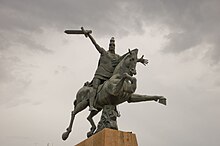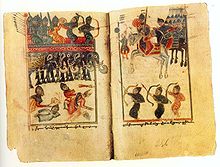Mamikonian
The Mamikonian ( Armenian Մամիկոնյան ) or Mamikonean ( classical Մամիկոնեան ) was a noble family that dominated Armenian politics between the 4th and 8th centuries. They ruled over the Armenian regions of Taron, Sasun , Bagrevand and others.
Legendary origin
The origin of the Mamikonian is unclear. In the 5th century, the historian Moses von Choren claimed in his History of Armenia that three centuries earlier two Chinese noblemen named Mamik and Konak rebelled against their half-brother Chenbakur, the ruler of the country of Chenk. They were defeated and fled to the Parthian king , who opposed the ruler's extradition request and sent them both to Armenia , where Mamik became the ancestor of the Mamikonian.
Another 5th century Armenian historian, Pawstos Buzand supported the history of origin. In his history of Armenia he mentions twice that the Mamikonian are descendants of the Chenk and as such were not among the Arsakid rulers of Armenia. The historical source name Chenk has been associated with China and the Han Dynasty by some historians .
The ancestry legend may well have been part of the Mamikonian politics and served to give their name more prestige. Although the legend resembles the claims of the Bagratids , who saw themselves as descendants of David , and the Artsruni , who saw themselves as the descendants of Assyrian kings, some Armenian historians tend to see it as more than just mythology.
A theory from the 1920s postulated that the Chenk from the Armenian sources were not the Chinese, but an ethnic group from Transoxania such as the Tocharers .
Edward Gibbon assumed in his book The History of the Decline and Fall of the Roman Empire that the founder of the Mamikonian was not a Chinese, but only from the Chinese Empire and that Mamgon is of Scythian origin, since the Chinese Empire in the west as far as Sogdia was enough.
Today some historians believe that the Mamikonian were descendants of the chiefs of the Tzans (in medieval Armenian: Chanik - Ճանիք / Ճենիք; in Medieval Greek: Tzannoi). The Tzans were a tribe that once inhabited the Bergisch regions in the south of Trabzon . Historians claim that the tradition of Chinese origin grew out of the similarity of the words Chanik and Chen-k (Armenian for China).
Early history
The first known Mamikonian prince ( Nakhararq ), about whom something certain is known, was a certain Vatche Mamikonian ( fl. 330–339). The family reappears in the chronicles in 355 for their possessions in the Tayk region . At the time, Vasak Mamikonian was the family leader. He was a Sparapet ( Commander in Chief ) of Armenia. Later the office of Sparapet was inherited only within the Mamikonian. Vasak Mamikonian was responsible for the defense of the Armenians against Persia , but was probably defeated by the betrayal of Marujan Ardzruni (approx. 367–368).
After the defeat, Vasak's brother Vahan Mamikonian and many other feudal lords moved to the Persian side. But Emperor Valens interfered in internal Armenian affairs and gave the office of Sparapet 370 to Vasak's son Muschegh Mamikonian. Four years later, the new King Varazdat Muschegh confirmed Mamikonian in office. Mushegh was later murdered at the behest of Sembat Saharuni, who replaced him as Sparapet.
After this event, the new head of the family became the brother of Mushegh Enmanuel Mamikonian, who was held hostage in Persia. Suddenly the Mamikonians revolted and tracked down Varazdat and Saharuni in Karin. Enmanuel, together with his sons Hemaiak and Artches, captured the king and locked him in a fortress, from which Varazdat fled. Zarmandukht, the widow of the predecessor Varazdats, was proclaimed queen. Enmanuel was able to come to terms with the powerful Sassanids by offering his loyalty in exchange for respect for Armenian autonomy and laws.
After the queen's death in 384, Enmanuel Mamikonian was proclaimed regent of Armenia and married the underage son of the deceased and new king Arsaces III. with his daughter Vardandukh. It was the death of Enmanuel in 385 that triggered the conquest of the country by the Persians in 386/387.
Vartan Mamikonian
Hamazasp Mamikonian is documented as a family leader in 393. His wife Sahakanoush was the only child of Isaac the Great and a descendant of the Arsakid kings. Her son Vartan Mamikonian was considered one of the greatest military and spiritual leaders of ancient Armenia. This marriage made the Mamikonians one of the largest landowners in all of Armenia.
After Vartan became Sparapet in 432, the Persians ordered him to Seleukia-Ctesiphon and forced him to convert to Zoroastrianism . After his return to his homeland in 450, he rejected the Persian religion and triggered a great Armenian uprising against the Sassanid overlords. He fell at the Battle of Avarayr in 451. Because he gave his life to defend his Christian faith and his people, the Armenian Church canonized him as Saint Vartan . An equestrian monument was erected in Yerevan in Vartan.
Vartan's nephew Vahan Mamikonian continues the fight for freedom. In the Treaty of Nvarsak in 484, Armenian autonomy was restored. The treaty guaranteed the continued existence of the Armenian statehood in the centuries to come.
After the subjugation of the country by the Persians, the Mamikonian sided with the Roman Empire and many of their family members entered Byzantine service. Not only did they rise to the highest offices in Constantinople, but some emperors such as Leo V and Basil I could be their descendants. Theodora II and her brothers Bardas and Petronas the patrician were also members of the Mamikonian.
Early Middle Ages
The history of the Mamikonian in the early Middle Ages is uncertain. In the period between 655 and 750 there are no documents about the Mamikonian. The following table of descendants for the period between the 5th and 7th centuries has been reconstructed. Grigor Mamikonian (r. 662–685) had a palace and a church built at his headquarters in Arutsch .
| Hamazasp I. Mamikonian |
Sahankanoysh of Armenia |
||||||||||||||||||||||||||||||||||||||||||||
| Hamazaspian | Vardan I. † 451 |
Hmayeak I † 452 |
|||||||||||||||||||||||||||||||||||||||||||
| Saint Shushanik † 472 |
Vahan | Vasak | Artaches | Vard | |||||||||||||||||||||||||||||||||||||||||
| Vard | Daughter name unknown |
Enmanuel son |
Vardan II son |
||||||||||||||||||||||||||||||||||||||||||
| Musel II. † approx. 592 |
Gaghik | Mamak ( fl. 590) |
|||||||||||||||||||||||||||||||||||||||||||
| Kahan Gail ( fl. 592–604) |
|||||||||||||||||||||||||||||||||||||||||||||
| Smbat the Brave ( fl. 604) |
|||||||||||||||||||||||||||||||||||||||||||||
| Musel III. † 640 |
|||||||||||||||||||||||||||||||||||||||||||||
| Grigor I ( fl. 650) |
Hamazasp II. ( Fl. 655) |
||||||||||||||||||||||||||||||||||||||||||||
The last Mamikonian
In 750 the Mamikonians lost Taron, Ahlat and Muş to the Bagratids. In the 770s the family was led by Artavizd Mamikonian, then by Musel IV († 772) and by Samuel II. The latter married his daughter to Smbat VII Bagratuni. His grandson Smbat Msaker (dt .: the meat eater ) became the forefather of the Bagratid rulers of Armenia and Taron.
The Mamikonian led a national rebellion against the Abbasid Caliphate in 774–775. After the rebels were defeated, the Mamikonian supremacy in Armenia came to an end. Even in their homeland of Tayk, they were ousted by the Bagratids. Kurdik Mamikonian regained control of Sasun around 800. Half a century later, Grigor Mamikonian lost Bagrevand to the Muslims, recaptured it in the early 860s and this time lost it to the Bagratids. After that, the Mamikonian disappeared from history.
After their disastrous uprising in 774, some princes emigrated to Georgia . The later Georgian noble families of the Liparitids-Orbeliani and the Tumanishvili are sometimes considered to be their descendants.
Individual evidence
- ^ Robert Bedrosian: China and the Chinese according to 5-13th Century Classical Armenian Sources.
- ↑ H. Skold, "L'Origine des Mamiconiens", Revue des etudes armeniennes (1925) pp. 134-35.
- ^ Edward Gibbon, The History of the Decline and Fall of the Roman Empire: Chapter XIII, Part II, Reign of Diocletian and This Three Associates. ( Memento of the original from July 31, 2001 in the Internet Archive ) Info: The archive link was inserted automatically and has not yet been checked. Please check the original and archive link according to the instructions and then remove this notice.
- ↑ Bryer, Antony. People and settlement in Anatolia and the Caucasus. Variorum Reprints, London. 1988, p. 187.
- ^ Hewsen, Robert H. (2001). Armenia: A Historical Atlas. The University of Chicago Press, p. 95. ISBN 0-226-33228-4
- ↑ Toumanoff, Cyril . "The Mamikonids and the Liparitids", Armeniaca (Venice, 1969), pp. 125-137.
Web links
- Mamikonian . In: Ehsan Yarshater (Ed.): Encyclopædia Iranica (English, including references)
- Resources for adults and children from Diocese of Armenian Church of America
- John Mamikonean's History of Taron



